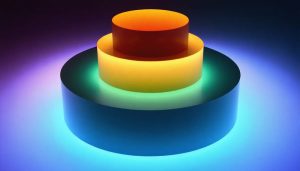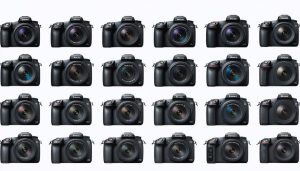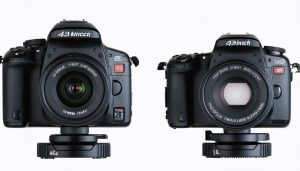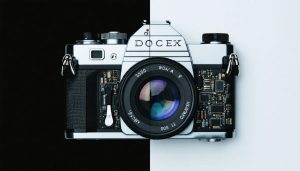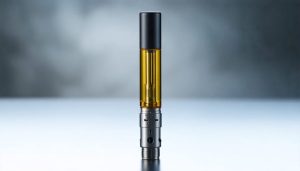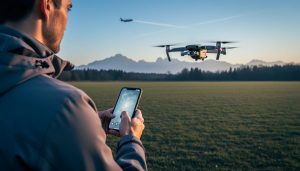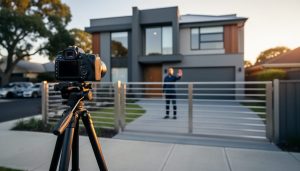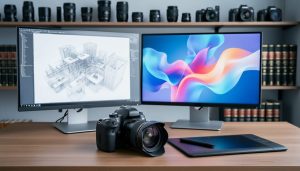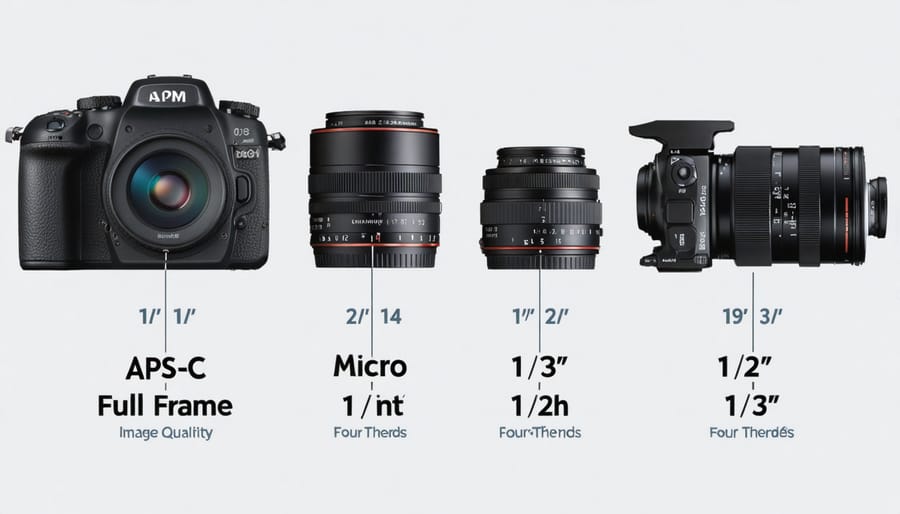
Understand the fundamentals of camera sensor size and its impact on your photography with this comprehensive camera sensor size comparison chart. Explore the key differences between Full Frame, APS-C, Micro Four Thirds, and 1-inch sensors, and learn how sensor size affects crucial aspects like image quality, low light performance, depth of field, and overall camera size and weight. With side-by-side visual comparisons and in-depth explanations, this article equips you with the knowledge to make informed decisions when selecting a camera or lens based on your specific needs and shooting style. Whether you’re a beginner looking to upgrade from a smartphone or a seasoned pro considering a new system, understanding camera sensor sizes is essential to unleashing your full creative potential.
Common Camera Sensor Sizes
1/2.3″ Sensors
1/2.3″ sensors are the smallest commonly used in digital cameras, typically found in compact point-and-shoot cameras and smartphones. While these tiny sensors enable ultra-portable camera designs, they come with some limitations compared to larger sensors.
Due to their small size, 1/2.3″ sensors struggle in low light conditions, producing more noise and less detail in dimly lit scenes. They also have a more limited ability to create shallow depth of field effects, making it harder to achieve the creamy bokeh background blur that many photographers desire for portraits and macro shots.
However, advancements in sensor technology and image processing have helped improve the performance of 1/2.3″ sensors in recent years. Many modern compact cameras and smartphones can still produce impressive images in good lighting conditions, making them a convenient choice for everyday photography and casual shooters who prioritize portability over ultimate image quality.
1″ Sensors
1″ sensors, commonly found in high-end compact cameras and bridge cameras, offer a step up in size and quality compared to smaller sensor types. These larger sensors allow for improved low light performance, capturing more detail and less noise in dimly lit scenes. The increased sensor size also enables a shallower depth of field, making it easier to achieve attractive background blur (bokeh) for portrait shots or creative effects. With a 1″ sensor, photographers can enjoy greater flexibility and control over their images, while still maintaining a relatively compact camera body. This sensor size strikes a balance between image quality and portability, making it a popular choice for enthusiasts who want to capture high-quality photos without the bulk of a larger camera system. As technology advances, 1″ sensors continue to improve, offering even better performance and features for photographers seeking a versatile and capable compact camera.
Micro Four Thirds Sensors
Micro Four Thirds sensors, popularized by camera manufacturers Olympus and Panasonic, offer a balance between compact camera body size and image quality. While smaller than APS-C sensors, Micro Four Thirds still delivers impressive results in a more portable package. This sensor size has gained popularity among photographers who value the convenience of smaller, lighter camera systems without sacrificing too much in terms of image quality.
One of the main advantages of Micro Four Thirds is the ability to design compact, high-quality mirrorless cameras and lenses. The smaller sensor allows for more petite camera bodies and optics, making it an attractive choice for travel, street, and everyday photography. Despite the smaller sensor size, Micro Four Thirds cameras can still produce excellent images with good detail, dynamic range, and low-light performance.
Another benefit of the Micro Four Thirds system is the extensive selection of lenses available from both Olympus and Panasonic, as well as third-party manufacturers. This provides photographers with a wide range of creative options, from wide-angle to telephoto, and fast prime lenses to versatile zooms. The smaller sensor also gives lenses an effective focal length multiplier of 2x, which can be advantageous for telephoto photography.
APS-C Sensors
APS-C sensors, measuring approximately 23.6mm x 15.6mm, have become the most common sensor size found in consumer digital SLRs and many mirrorless cameras. This sensor size offers a great balance between image quality, low light performance, and affordability, making it a popular choice among photography enthusiasts and professionals alike.
Compared to smaller sensor sizes like Micro Four Thirds, APS-C sensors have a larger surface area, allowing them to capture more light and produce images with lower noise levels, especially in low light situations. This increased light-gathering capability also enables shallower depth of field, making it easier to achieve attractive background blur (bokeh) for portraits and other creative applications.
While full-frame sensors still have an edge in terms of overall image quality and low light performance, APS-C sensors have come a long way in recent years, with many high-end models producing stunning results that rival their full-frame counterparts. Additionally, APS-C cameras and lenses are often more compact and lightweight, making them an excellent choice for photographers who value portability without sacrificing too much in terms of image quality.
In summary, APS-C sensors provide an excellent balance of image quality, low light performance, and value, making them a popular choice among a wide range of photographers.
Full Frame Sensors
Full frame sensors, measuring approximately 36mm x 24mm, are the largest commonly available sensor size in modern digital cameras. Revered by professionals and serious enthusiasts alike, full frame cameras deliver unparalleled image quality, exceptional low light capability, and superior depth of field control. The expansive sensor area allows for larger individual pixels, which translates to improved light gathering capacity, reduced noise, and enhanced dynamic range. This enables full frame cameras to capture stunningly detailed images with rich colors and smooth tonal transitions, even in challenging lighting conditions. Moreover, the larger sensor size provides a shallower depth of field at wider apertures, enabling photographers to achieve beautiful background blur and subject separation, a coveted effect in portraiture and other creative applications. While full frame cameras often come with a higher price tag and larger, heavier lenses, the remarkable image quality and versatility they offer make them the gold standard for those who demand the very best in their photography.
Medium Format Sensors
Medium format sensors, found in high-end and specialized cameras, offer unparalleled image quality that surpasses even full frame sensors. These massive sensors, often measuring around 53.4 x 40mm or larger, capture an incredible amount of detail, depth, and dynamic range. The increased surface area allows for larger individual pixels, resulting in superior low-light performance and reduced noise. However, this exceptional image quality comes at a cost – medium format cameras are significantly more expensive and bulkier than their full frame counterparts. They are primarily used by professional photographers in studio, landscape, and fine art photography where ultimate image quality is paramount.
Sensor Size Comparison Chart
Here is a visual comparison of the different camera sensor sizes discussed in this article:

The chart above shows the relative sizes of various digital camera sensors, from the tiny 1/2.3″ sensors found in many smartphones and compact point-and-shoot cameras, up to the large full frame sensors used in professional DSLRs and mirrorless cameras.
Beneath each sensor size, common camera models and types are listed to give you a practical idea of where these sensors are used. For example, APS-C sensors, which have a crop factor of around 1.5x compared to full frame, are widely used in entry-level to enthusiast-oriented interchangeable lens cameras like the Canon Rebel series, Nikon D5x00 series, and Sony A6x00 series.
The medium format sensors, even larger than full frame, are typically found in high-end cameras favored by professional studio and landscape photographers, such as the Fujifilm GFX, Hasselblad X1D, and Leica S systems. These offer the ultimate in image quality and resolution but come with significant size, weight, and cost.
Looking at the chart gives you an appreciation for just how much sensor sizes can vary. This has major implications for low light performance, depth of field, dynamic range, and overall image quality between different camera types. Refer to the other sections for more details on how sensor size impacts these key aspects of photography.
Impact of Sensor Size
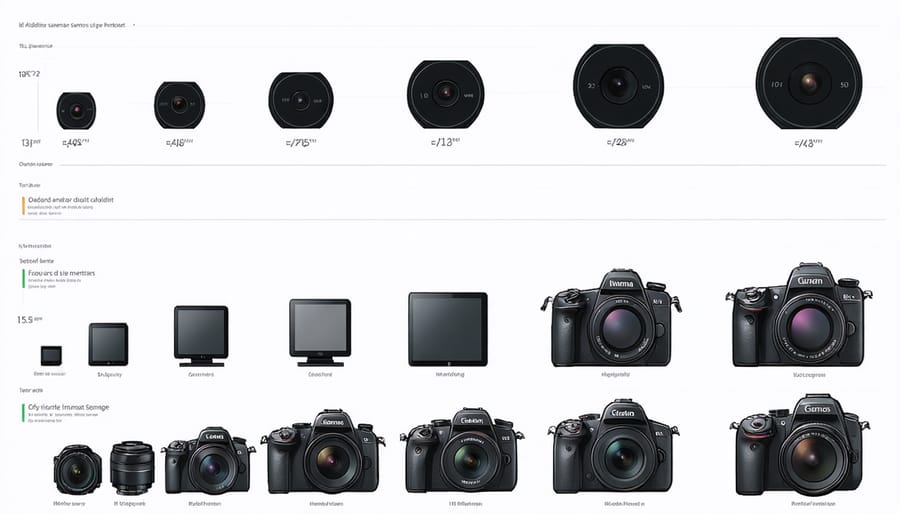
Image Quality and Noise
Sensor size plays a crucial role in determining image quality. Larger sensors typically offer higher resolution, allowing for more detailed images with less noise. They also tend to have better dynamic range, capturing a wider range of tones from deep shadows to bright highlights. This is especially beneficial when shooting in challenging lighting conditions or high-contrast scenes.
Furthermore, larger sensors generally excel in low light performance, producing cleaner images with less noise at higher ISO settings. This is due to the larger individual pixels on the sensor, which can gather more light. As a result, cameras with larger sensors are often preferred for night photography, indoor shooting, and other situations where light is limited.
Depth of Field and Bokeh
Sensor size plays a significant role in achieving shallow depth of field and smooth bokeh, the pleasing out-of-focus areas in an image. Generally, larger sensors have a greater capacity to produce shallow depth of field compared to smaller sensors. This is because, for a given aperture and focal length, a larger sensor requires a longer actual focal length lens, resulting in reduced depth of field. For instance, a full-frame sensor can create a shallower depth of field than an APS-C sensor using the same aperture and field of view. Larger sensors also typically have larger individual pixels, which can contribute to smoother, more appealing bokeh rendering. However, it’s important to note that factors such as aperture, focal length, and subject distance also significantly impact depth of field and bokeh.
Camera Size and Portability
While larger sensors offer superior image quality, they come with the tradeoff of increased camera size and weight. Full-frame cameras, with their impressive low-light performance and wide dynamic range, are often bulkier and heavier than their crop-sensor counterparts. This can impact portability and ease of use, especially for travel or outdoor photography. On the other hand, smaller sensor cameras, such as those with 1-inch or Micro Four Thirds sensors, provide a more compact and lightweight option without sacrificing too much in terms of image quality. These cameras are ideal for casual shooters or professionals who prioritize portability. Ultimately, the decision between sensor size and camera size depends on your specific needs and shooting style.
Conclusion
In conclusion, understanding camera sensor sizes is crucial for making informed decisions about your photography gear. From the compact 1/2.3″ sensors in smartphones and point-and-shoots to the expansive full-frame and medium format sensors in professional cameras, each size has its strengths and weaknesses in terms of image quality, low-light performance, depth of field control, and overall camera size and cost. While larger sensors generally offer superior image quality and versatility, they also come with higher price tags and bulkier camera bodies. Ultimately, the right sensor size for you depends on your specific needs as a photographer, whether you prioritize portability, budget, or uncompromising image quality. By carefully considering the trade-offs and aligning your choice with your photographic style and goals, you’ll be well-equipped to capture stunning images that showcase your unique creative vision.

